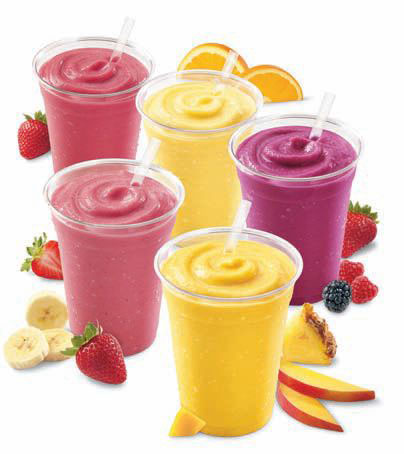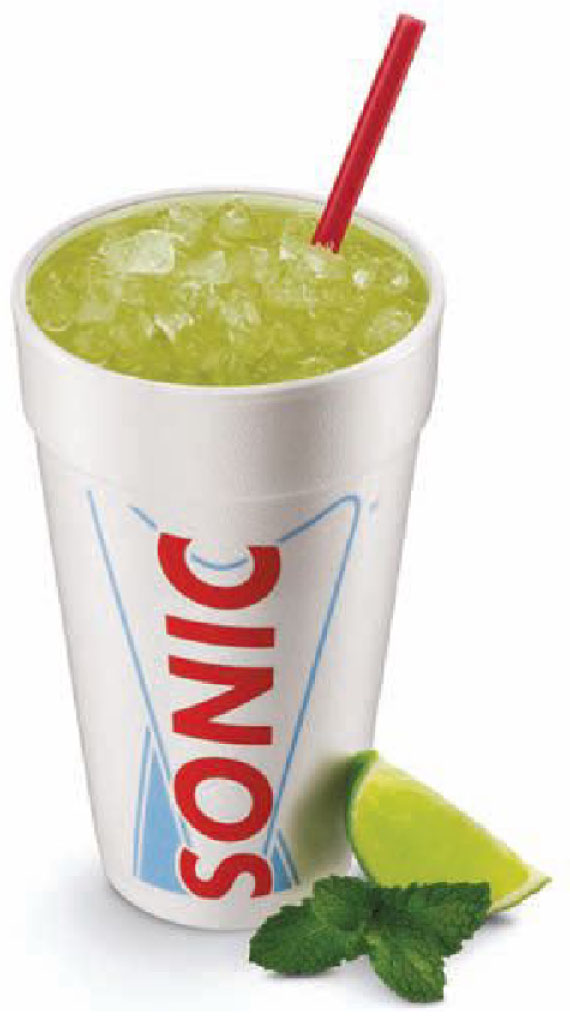
Dairy Queen launched its new line of Orange Julius
Light Smoothies this year. These smoothies contain
170 calories or fewer in each small serving, the
company says. (Image courtesy of American Dairy
Queen Corp.)

Sonic launched a line of freshly brewed
sweet and diet green iced teas available in
numerous different fl avors. (Image courtesy
of Sonic Corp.)
|
Technomic reports that overall food and nonalcohol
beverage sales in the foodservice industry
reached more than $625 billion in 2013, achieving
3.8 percent nominal growth and 0.9 percent actual
growth, according to its May 2013 data. This
includes venues in schools; medical facilities;
lodging, transportation and recreation areas; and
military bases, as well as caterers; restaurants;
and foodservice in supermarkets, convenience
stores and other retailers. Technomic also predicts
that this growth will continue into 2014 with
4.1 percent nominal growth and 1.1 percent
actual growth.
More specifically, nominal restaurant sales rose
4.2 percent to $425.6 billion in 2012, according to
the 23rd edition of the “Chain Restaurant Industry
Review” by GE Capital, Franchise Finance (GEFF),
Scottsdale, Ariz. Full-service restaurant sales
increased 3.1 percent to $202.2 billion, while
quick-service restaurant sales increased 5.6 percent
to $179.3 billion, it reports. GEFF also projects
that restaurant sales will increase 3.8 percent to
$441.9 billion this year. This growth is a sign that
U.S. consumers are more confident about their
disposable income levels, it states.
Technomic’s Pawlak adds that consumer time
constraints also are fueling channel growth. “People
don’t have time to cook anymore at home,” he says.
“They go out to eat, and even if they’re not eating at a
restaurant, they’re taking out, taking it home, or taking
it to lunch in their offices.”
In addition to this convenience factor, consumers
expect value from foodservice venues, according
to Chicago-based Mintel’s April 2013 report, “The
Dining Out Experience – US.” In a November 2012
survey, Mintel found that 40 percent of consumers
interviewed had taken advantage of value or dollar
menu options in the last month, while 38 percent
used coupons from newspapers, mailings and other
advertisements, it reports.
LIGHT VS. INDULGENT
Low-calorie menu options also are helping
foodservice venues please consumers. According
to Washington, D.C.-based Hudson Institute’s
February 2013 report, “Lower-Calorie Foods,”
chains that increased their lower-calorie food
servings experienced increases in overall food
servings while other chains recorded declines
from 2006 to 2011. In line with this, the company
also reported that within the 21 restaurant
chains analyzed, including McDonald’s, Burger
King, Wendy’s, Sonic, Panera Bread, Taco Bell,
Applebee’s, Cracker Barrel, Chili’s, IHOP and Olive
Garden, among others, lower-calorie beverage
options, specifically those containing 50 or fewer
calories in each 8-ounce serving, outperformed
traditional beverages. In 2011, lower-calorie
beverages captured 34.1 percent of total beverage
sales in the channel with a 9.5 percent increase in
servings, compared with a 1.6 percent increase for
traditional beverage servings and a 4.1 percent
increase for total beverage servings, the Hudson
Institute reports, citing data from NPD Group,
Port Washington, N.Y.
Low-calorie beverage options continue to pop
up on foodservice menus this summer as well.
Minneapolis-based Dairy Queen introduced its
Orange Julius Light Smoothies as part of its national
roll-out of Orange Julius Premium Fruit Smoothies
and Julius Originals to its more than 4,000 Dairy
Queen locations in the United States and Canada.
Orange Julius Light Smoothies, which contain 170
calories or fewer in a small smoothie, are made with
real fruit, do not contain any artificial flavors, and are
available in Orange, Strawberry, Strawberry Banana,
Tripleberry, Mango Pineapple, Berry-Pom, Orange
Berry and Piña Colada varieties.
Similarly, Caribou Coffee Co. Inc., Minneapolis,
added four “lite” sparkling teas and juices to its
Caribou coffeehouse menus. The drinks contain half the amount of calories of Caribou’s
original sparkling teas and juices, are
made with real fruit and tea, and are
available in Green Tea Lemonade,
Peach Black Tea and Lemon Ginger
Pomegranate varieties as well as a
limited-time Apple Raspberry variety.
On the flipside of this trend,
consumers also are using beverages
from the foodservice channel to
indulge themselves, Technomic’s
Pawlak notes. “I think consumers are
still indulging themselves in those
types of beverages, whether they be
coffee, specialty coffee beverages,
or smoothies or frozen-fruit-type
drinks,” he says. “There’s still a lot of
growth in that area.”
Specialty coffee is growing very
solidly, Pawlak says. “We’re seeing
good growth there as more and more
operators are getting involved and
offering those products,” he explains.
“Consumers no longer just think about
coffee for breakfast; they think about it
for a mid-afternoon snack or even as a
dessert for dinner.”
This year, Miami-based Burger
King refreshed its coffee platform
with 10 new specialty blended coffee
drinks featuring a new, 100-percent
Latin American Arabica coffee bean
custom blend brewed by Seattle-based
Seattle’s Best Coffee, a wholly owned
subsidiary of Starbucks Coffee Co.
The new lineup includes Vanilla-,
Mocha- and Caramel-flavored hot and
iced coffees as well as Plain, Vanilla,
Caramel and Mocha latte varieties.
For other indulgent options, Oak Brook, Ill.-based McDonald’s added
a Dulche de Leche shake and a
Blueberry Pomegranate smoothie
to its McCafe menu for the summer.
Inspired by a traditional Latin
American dessert, the seasonal
Dulche de Leche shake is made with
McDonald’s Vanilla reduced-fat ice
cream and caramel syrup and is
topped with whipped cream and
a cherry, the company says. The
Blueberry Pomegranate smoothies,
which start at 220 calories for a small
size, are made with blueberries,
raspberries, a splash of pomegranate
juice and low-fat yogurt, it says.
Technomic’s Pawlak notes that
specialty beverages, particularly
smoothies, now are serving as snacks
and meal substitutes, expanding these
drinks’ usage occasions.
COMPLEMENTARY
CATEGORIES
As beverages for meal
accompaniments, Pawlak notes
that iced tea and bottled water are
performing well in the foodservice
segment as consumers move away
from carbonated soft drinks, which
have stabilized in recent years. Iced tea
is doing especially well because of the
value it offers foodservice operators,
he says. “It’s very, very high in margin
for the foodservice operator, so they’re
more likely to push that item because
they’re making money on it,” he
explains.
Although Pawlak says that most of
the iced tea growth is in traditional
varieties — whether sweetened or
unsweetened — Sonic is adding some
more flavorful options to the mix.
This year, the Oklahoma City-based
franchise launched a line of freshly
brewed sweet and diet green iced teas
available in numerous flavor options,
including its five newest sugarfree
flavor mix-ins: Peach, Mango,
Raspberry, Blackberry and Mint.
“Because we are all about choices,
we didn’t launch just one or two iced
tea varieties but launched sweet and
diet green iced tea with five new
sugar-free flavor mix-ins,” said James
O’Reilly, Sonic’s chief marketing
officer, in a statement. “These new
flavors, combined with our thousands
of other iced tea flavor options, make
it fun to make healthy choices.”
|
|